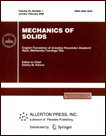 | | Mechanics of Solids
A Journal of Russian Academy of Sciences | | Founded
in January 1966
Issued 6 times a year
Print ISSN 0025-6544
Online ISSN 1934-7936 |
Archive of Issues
| Total articles in the database: | | 13362 |
| In Russian (Èçâ. ÐÀÍ. ÌÒÒ): | | 8178
|
| In English (Mech. Solids): | | 5184 |
|
| << Previous article | Volume 59, Issue 5 / 2024 | Next article >> |
| C. Dai, Y.C. Fu, Y.F. Cao, H.Y. Lyu, and C. Xu, "Study on the Vibration Response of an Automatic Rifle Barrel in Hot and Cold States," Mech. Solids. 59 (5), 3163-3181 (2024) |
| Year |
2024 |
Volume |
59 |
Number |
5 |
Pages |
3163-3181 |
| DOI |
10.1134/S0025654424605299 |
| Title |
Study on the Vibration Response of an Automatic Rifle Barrel in Hot and Cold States |
| Author(s) |
C. Dai (Nanjing University of Science and Technology, Nanjing, 210094 China)
Y.C. Fu (Equipment Research Institute of Inner Mongolia North Heavy Industries Group Co., Ltd, Baotou, 014000 China)
Y.F. Cao (Nanjing University of Science and Technology, Nanjing, 210094 China)
H.Y. Lyu (Nanjing University of Science and Technology, Nanjing, 210094 China)
C. Xu (Nanjing University of Science and Technology, Nanjing, 210094 China, xucheng62@mail.njust.edu.cn) |
| Abstract |
To gain a deeper understanding of the vibration characteristics of an automatic rifle barrel
in both hot and cold states, a non-contact measurement method was used to measure the amplitude
and vibration velocity of the barrel during single and repeated shots of a small-caliber automatic rifle.
Displacement and velocity curves of the barrel vibration were obtained, and the muzzle vibration in
hot and cold states was compared. The study also analyzed the effects of firing loads and the elastic
modulus of the barrel material on the barrel’s vibration in a hot state, as well as the applicability of the
eccentric rotating stepped beam model. The formation mechanism of the differences in vibration
response between hot and cold states was revealed. The research results show that: (1) In both hot and
cold states, the muzzle vibration pattern begins with a downward movement of the muzzle, followed
by a significant upward motion. After three cycles of forced vibration as the bullet exits the muzzle, the
barrel enters a free-damping vibration state until the vibrations dissipate. During Repeated shots, the
barrel vibration accumulates, resulting in a larger amplitude than single-shot firing. (2) In the hot
state, the barrel’s amplitude and velocity increase, while the vibration frequency decreases. The main
reasons for the increased amplitude in the hot state are the decrease in the elastic modulus of the barrel and the increased firing load. (3) The eccentric rotating stepped beam model applies to calculating
muzzle vibration in the hot state. |
| Keywords |
hot and cold rifles states, automatic rifle, barrel vibration, impact load, beam model |
| Received |
08 September 2024 | Revised |
29 October 2024 | Accepted |
01 November 2024 |
| Link to Fulltext |
|
| << Previous article | Volume 59, Issue 5 / 2024 | Next article >> |
|
 If you find a misprint on a webpage, please help us correct it promptly - just highlight and press Ctrl+Enter If you find a misprint on a webpage, please help us correct it promptly - just highlight and press Ctrl+Enter
|
|

 Russian
Russian  English
English